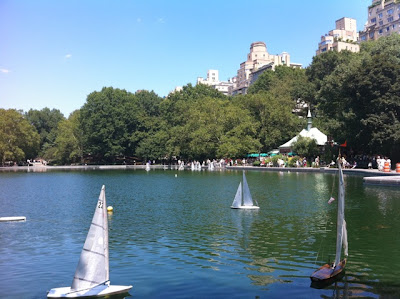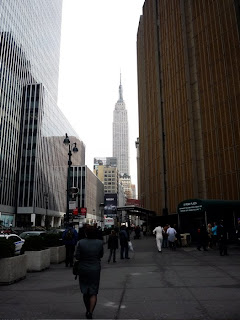Strolling the uptown museums and nearby Central Park is a time-honored New York pastime dating back to the days of the nineteenth century century flâneur. During the nineteenth century, the building of the park and later the great Beaux Arts buildings of monumental New York, most notably here the Metropolitan Museum of Art, brought out thousands of men and women to admire the natural and artistic wonders of the great city. For the nineteenth century observer, Central Park, the museums, and other attractions made the city a great scene to behold, achieving a cultural status rivaling the great cities of Europe.
 |
| Conservatory Water, Central Park, July 2010. |
From
Lloyd's pocket companion and guide through New York City, for 1866-67 by Thomas Lloyd:
 |
| The Pond, Central Park, looking to the southeast corner of 59th St. and Fifth Avenue. July 2010. |
From
a visitor's account in 1884:
 |
lawn to the east of the Bethesda Terrace, Central Park. July 2010.
|
From
The city of New York: a complete guide, with descriptive sketches of objects and places of interest, 1890:
 |
| Bethesda Terrace and Fountain, Central Park. July 2010 |
A visit to the museums followed by a walk in Central Park can connect the contemporary urban walker to those who strolled the same paths over a century ago. Just a few tricks of the imagination and the squinting of the eyes can bring forth the older city - Here, the residents of the great metropolis slowly walk arm and arm among the antiquities, or they sit on a museum bench in a smoldering stare, like Newland Archer and Ellen Olenska in Edith Wharton's
The Age of Innocence. The women carefully proceed up the paths in their long bustled overskirts. The men of the upper classes sport ascots, a waistcoat, and a top hat. We may not dress ourselves in the same studied fashion, but just like us they are strolling to Bethesda Terrace or to the Ramble or over a bridge down to the Pond. If we put down out portable devices long enough and look through our imaginations, their shadows may appear. They are there - in the next gallery of paintings or along the curved path ahead.
From
A week in New York by Ernest Ingersoll, 1891:
 |
| Sheep Meadow, Central Park | |
From
The treasures of the Metropolitan museum of art of New York by Arthur Hoeber, 1899:

While many museums sit along the northern reaches of the park in the area known as Museum Mile, this suggested self-guided stroll is designed for visitors to the Whitney, Frick, or even MoMA (to the south). Begin with the museum visit followed by a 2-mile walk in the park.
View For the Flâneurs: After the Museums, A Walk in Central Park in a larger map
The freely drawn line on the map merely suggests a few points of interest in Central Park - the Conservatory (sailboats), the Boathouse (a proper flâneur would stop for a drink), the Bethesda Terrace (sublime vistas), the Sheep Meadow (for a gander at the bathers), the carousel, and the Pond. Stopping at the zoo to watch animal antics is entirely optional.
 |
From New York City standard guide: a new and complete handbook for visitors to New York, and for New Yorkers, Foster & Reynolds, 1901 |
Read the related post,
A Walk in the Ramble.
Images: Contemporary images of Central Park by Walking Off the Big Apple from July 31, 2010, following a visit to the Whitney Museum.












I have witnessed presidential visits since Jimmy Carter, who I first saw walking across 7th Avenue from the Sheraton Center (I think it was still the Americana Hotel back then) with Rosalyn and Miss Lillian in tow (I have never seen a more wrinkled woman) to get to the Stage Deli for breakfast.
ReplyDeleteI've probably seen more than 20 presidential motorcades, yet there is always something exciting about it. Just the herd of motorcycles announcing the parade of power and the mobile Intensive Care Center (no mere ambulance will do) that trails behind. All for one man. It must cost a fortune.
Yes, while this might properly reference the other post about the President on Sullivan Street, I still thank you for your comment.
ReplyDeleteYes, it must cost a fortune, and the bystanders with me mostly commented along the same lines.
One of my favorite essays of all-time belongs to the timeless Lillian Ross of The New Yorker who once wrote an essay about Richard Nixon's post-Watergate life in New York City. In the essay she described what Nixon must have noticed while he walked the two hundred and forty-eight steps from his residence to his office in the Hotel Pierre.(collected in the book of essays, Reporting Back.)